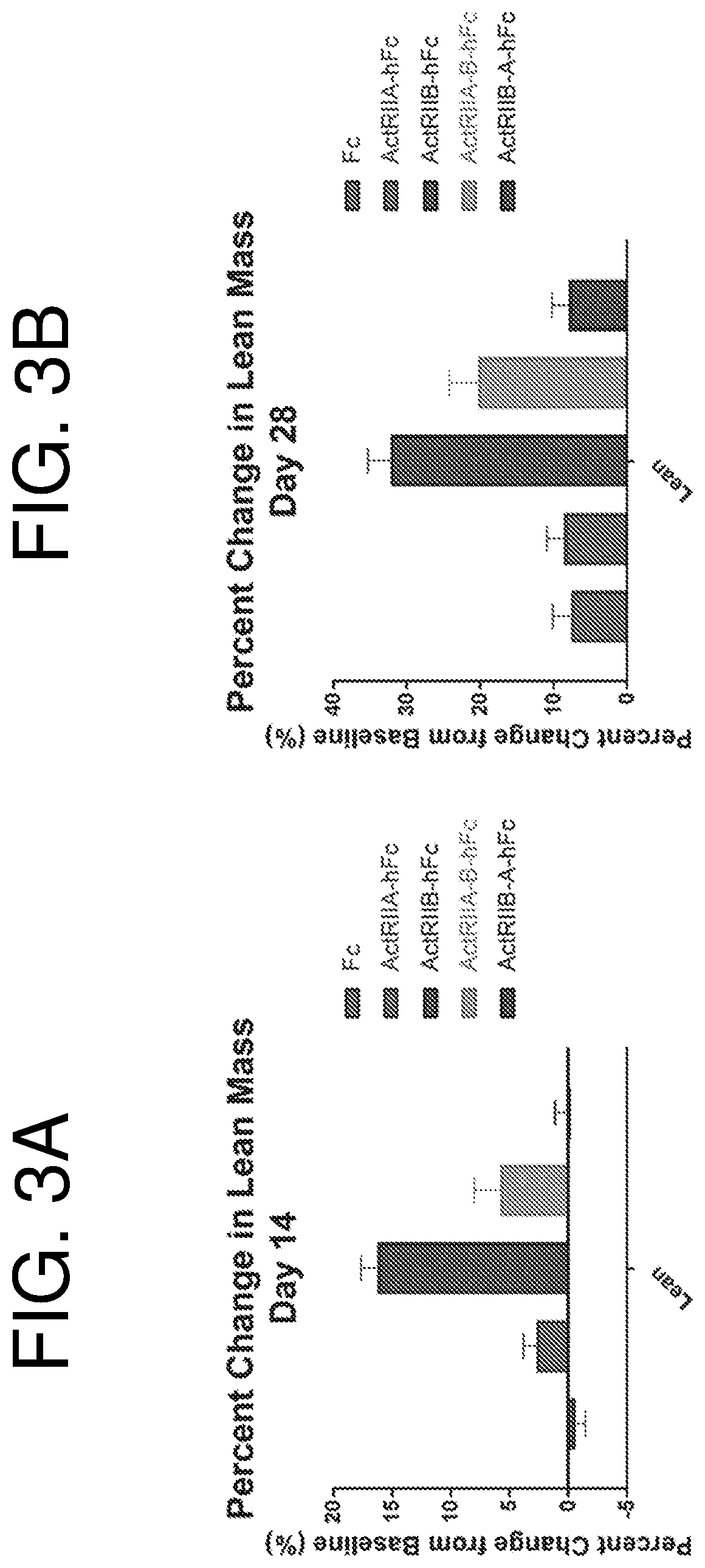Activin receptor type iia variants and methods of use thereof
a technology of activin receptor and variant, applied in the field of activin receptor type iia variant, can solve the problems of increasing body weight, affecting the failing to improve the treatment and survival of subjects with devastating muscle diseases, so as to increase muscle mass and strength, increase the stability of polypeptides, and reduce body weight
- Summary
- Abstract
- Description
- Claims
- Application Information
AI Technical Summary
Benefits of technology
Problems solved by technology
Method used
Image
Examples
example 1
Extracellular ActRIIa Variants on Body Weight
[0178]C57BI / 6 mice received a single hydrodynamic injection of a plasmid construct encoding one of the following six polypeptides (n=10 / group):
[0179](1) human Fc (hFc),
[0180](2) extracellular ActRIIa (SEQ ID NO: 73) fused to the N-terminus of hFc through a GGG linker;
[0181](3) extracellular ActRIIb (SEQ ID NO: 74) fused to the N-terminus of hFc through a GGG linker;
[0182](4) extracellular ActRIIa variant (SEQ ID NO: 69) fused to the N-terminus of hFc through a GGG linker; and
[0183](5) extracellular ActRIIb variant (SEQ ID NO: 149) fused to the N-terminus of hFc through a GGG linker.
[0184]100 μg of plasmid construct was delivered in a volume of 10% body weight over 5-8 seconds. The high volume and short period of injection provides the pressure needed to introduce the plasmid into the liver cells where the plasmid will be expressed, specifically the proteins of interest are expressed under a strong and ubiquitous promoter. The protein of i...
example 2
Extracellular ActRIIa Variants on Muscle Mass
[0185]Mice received a single hydrodynamic injection of a plasmid construct encoding one of the following six polypeptides (n=10 / group):
[0186](1) human Fc (hFc),
[0187](2) extracellular ActRIIa (SEQ ID NO: 73) fused to the N-terminus of hFc through a GGG linker;
[0188](3) extracellular ActRIIb (SEQ ID NO: 74) fused to the N-terminus of hFc through a GGG linker;
[0189](4) extracellular ActRIIa variant (SEQ ID NO: 69) fused to the N-terminus of hFc through a GGG linker; and
[0190](5) extracellular ActRIIb variant (SEQ ID NO: 149) fused to the N-terminus of hFc through a GGG linker.
[0191]100 μg of plasmid construct was delivered in a volume of 10% body weight over 5-8 seconds. The high volume and short period of injection provides the pressure needed to introduce the plasmid into the liver cells where the plasmid will be expressed, specifically the proteins of interest are expressed under a strong and ubiquitous promoter. The protein of interest ...
example 3
Extracellular ActRIIa Variants on Body Weight When Administered as Purified Recombinant Protein
[0192]Female C57BI / 6 mice (Taconic Biosciences, Hudson N.Y.) received an intraperitoneal injection of tris-buffered saline vehicle or one of the following five purified recombinant polypeptides at a dosage of 10 mg / kg twice weekly for four weeks (n=10 / group):
[0193](1) tris-buffered saline vehicle,
[0194](2) extracellular ActRIIa (SEQ ID NO: 73) fused to the N-terminus of hFc through a GGG linker;
[0195](3) extracellular ActRIIb (SEQ ID NO: 74) fused to the N-terminus of hFc through a GGG linker;
[0196](4) extracellular ActRIIa / b variant (SEQ ID NO: 69) fused to the N-terminus of hFc through a GGG linker;
[0197](5) extracellular ActRIIa / bΔ9 variant (SEQ ID NO: 58) fused to the N-terminus of hFc through a GGG linker; and
[0198](6) extracellular ActRIIa / bΔ9 min variant (SEQ ID NO: 6) fused to the N-terminus of hFc through a GGG linker.
[0199]Purified recombinant protein was made by transient expres...
PUM
| Property | Measurement | Unit |
|---|---|---|
| width | aaaaa | aaaaa |
| muscle mass | aaaaa | aaaaa |
| body weight | aaaaa | aaaaa |
Abstract
Description
Claims
Application Information
 Login to View More
Login to View More - R&D
- Intellectual Property
- Life Sciences
- Materials
- Tech Scout
- Unparalleled Data Quality
- Higher Quality Content
- 60% Fewer Hallucinations
Browse by: Latest US Patents, China's latest patents, Technical Efficacy Thesaurus, Application Domain, Technology Topic, Popular Technical Reports.
© 2025 PatSnap. All rights reserved.Legal|Privacy policy|Modern Slavery Act Transparency Statement|Sitemap|About US| Contact US: help@patsnap.com



